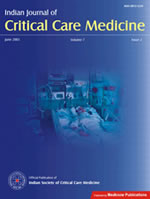
|
Indian Journal of Critical Care Medicine
Medknow Publications on behalf of the Indian Society of Critical Care Medicine
ISSN: 0972-5229
EISSN: 0972-5229
Vol. 14, No. 1, 2010, pp. 35-39
|
 Bioline Code: cm10007
Bioline Code: cm10007
Full paper language: English
Document type: Research Article
Document available free of charge
|
|
|
Indian Journal of Critical Care Medicine, Vol. 14, No. 1, 2010, pp. 35-39
| en |
Effectiveness of early start of direct hemoperfusion with polymyxin B-immobilized fiber columns judging from stabilization in circulatory dynamics in surgical treatment patients
Sakamoto, Yuichiro; Mashiko, Kunihiro; Obata, Toru; Matsumoto, Hisashi; Hara, Yoshiaki; Kutsukata, Noriyoshi & Yokota, Hiroyuki
Abstract
Background: Septic shock remains a major cause of multiple organ failure and is associated with a high mortality rate. In 1994, direct hemoperfusion using a polymyxin B-immobilized fiber column (PMX; Toray Industries Inc., Tokyo Japan) was developed in Japan and has since been used for the treatment of septic shock arising from endotoxemia. Materials and Method: We treated 36 patients with septic shock using direct hemoperfusion with PMX. The patients were analyzed in two groups based on whether they had undergone surgery prior to DHP-PMX treatment (surgical group: surgical treatment before DHP-PMX, medical group: no surgical treatment). In surgical group, DHP-PMX was started within three hours after the surgical treatment. Various factors were measured before and after DHP-PMX. Results: The mean Acute Physiology and Chronic Health Evaluation (APACHE) II score was 27.4 ± 8.8, and the mean sepsis-related organ failure assessment (SOFA) score was 11.8 ± 4.9 before DHP-PMX. The SOFA score was significantly higher (P = 0.0091) and the PaO2/FiO2 ratio (P/F ratio) was significantly lower (P = 0.0037) in medical group than in surgical group prior to DHP-PMX. A chi-square test showed that the survival rate in surgical group was significantly better than in medical group (P = 0.0027). The survival rate of surgical group (84.2%) was judged to be very good because the predicated survival rate based on the APACHE II score (25.0) was only 46.5%. On the other hand, the survival rate of medical group (35.3%) was almost equal to that predicted by the APACHE II score (30.6; predicted survival rate, 27.4%). Conclusion: The results of this study suggest the utility of early DHP-PMX in surgical group.
Keywords
Early goal directed therapy, polymyxin B-immobilized fiber column (PMX), septic shock
|
| |
© Copyright 2010 Indian Journal of Critical Care Medicine.
Alternative site location: http://www.ijccm.org/
|
|
